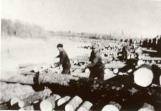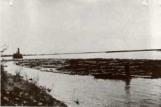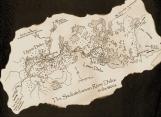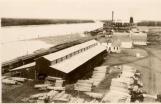1
SETTLEMENT AND INDUSTRIALIZATIONBy the turn of the century the development of railways across the prairies brought an end to the extensive use steamboats for the transport of trade goods and settler's freight on the Saskatchewan River. A few industries, however, continued to use the river for their operations, primarily for industrial haulage.
3
The Log DrivesPrior to 1908, logging and lumbering in the area of The Pas was limited to filling the needs of local people for construction and boat building. With the construction of the railroad to the community in 1908, ready transportation became available for shipping lumber to markets beyond the local area, markets in southern Canada and the United States. In fact, it was largely through the lobbying efforts of U.S. lumberman Herman Finger that the railroad was routed to The Pas.
Finger's plan was to produce lumber from the vast timber reserves fringing the Saskatchewan River and it's tributaries. Once the railroad reached The Pas, Finger built a mill and started the Finger Lumber Company, which was in operation from 1910 until 1919. Active in community affairs, Finger became town's first mayor, and is considered by many as 'The Father of The Pas'.
Finger sold the operation to the Winton brothers in 1919 and the name was changed to The Pas Lumber Company, a company that operated at The Pas until 1958, (and is still in operation in British Columbia today).
5
As in many remote regions of Canada's north, transporting logs through untracked wilderness was not an option - there were no roads. The rivers afforded an economical and natural means of getting the logs from bush to mill, and for nearly 50 years the mill at The Pas was fed by the annual log drive.The drive began each year with the spring high water, shortly after the ice went out. Usually interrupted when water levels dropped in June or July, the drive often resumed when the levels rose again, fed by the flow of summer meltwater from the Rocky Mountains. Logs that had been stockpiled at the rivers edge throughout the winter were rolled from the landings into the river, then floated to booms on the Carrot River, and from there to The Pas.
7
As lumber companies extended further afield in the search for more timber, logs were driven 150 miles from timber berths edging the Saskatchewan River west of Sipanok Channel, a braid of the Saskatchewan River in the upper delta. The channel had to be dredged to keep it open. An extensive system of booms diverted logs through the Sipanok, then down the Carrot River to a boom camp at its mouth.From there small steam boats towed rafts of logs, as needed, to the bridge across the Saskatchewan River at The Pas. The logs were released and drifted into a boom in front of the mill. With river levels that could fluctuate wildly over as little as a few days, and the presence of shifting sandbars, only shallow-draught steamboats could navigate the channels of the Saskatchewan River. Some years, as in 1930, the water levels failed to rise enough to float rafts of logs.
8
Landing at Sipanok Channel in the winter of 1938, in February or March.1938
The Pas, Manitoba, Canada

9
The Sipanok channel is one of three main channels of the Saskatchewan River in the upper delta area. It drained into the Carrot River then it emptied back in Saskatchewan River just west of The Pas. This river channel was vital to the log drive in the early lumber industry history in The Pas.However, shifting channels resulted in lower water levels in later years. The difficulty of driving logs in the Sipanok Channel during the 1930s led The Pas Lumber Co. to trade its timber berths lying west of Sipanok for Saskatchewan Government timber on the banks of Old Channel, (another of the Saskatchewan River's three channels west of The Pas in the upper delta).
11
Log drivers on a log boom holding pike poles to maneuver logs.May, 1930
Carrot River, Manitoba, Canada

12
The bane of the river drive was the logjam. Smaller jams could be cleared by hand with pike poles and expertly applied leverage, but often the drivers had to use dynamite to break up a large jam.It was dangerous work and many "river rats" were injured or drowned trying to loosen a logjam. Those who drowned were often laid to rest in graves along the shore, as there was no means for shipping their remains to far flung homes in distant parts of Canada, the U.S. or overseas.
Oftentimes loggers were farmers, working in the bush during winter to supplement farm income and support family back home. During the years of the Great Depression, many unemployed came north to seek wages in the lumber camps during the winter and on the river drives in the summer.




